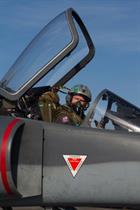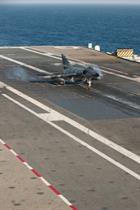Lt Cdr Ian Sloan RN – Flying with the Aeronavale
For the last two years I have had the good fortune to serve on exchange with the French Navy, flying the Super Etendard Modernisé (SEM) both ashore, from Landivisiau and embarked, from the French aircraft carrier Charles De Gaulle (CDG).
Fixed Wing RN pilots flying with the French Navy is nothing new – but it has been a while since the days of the Buccaneer exchange to Etendard IV (and that was in the south of France – how times have changed!). Retirement of the Harrier gave cause to reinvigorate the relationship, helped along by the Lancaster House Agreement, signed in 2010, promoting closer military ties between the two countries.
The exchange also served to aid the ‘Long Lead Specialist Skills’ program, introduced to maintain embarked maritime aviation experience as the Queen Elizabeth Class joins the fleet. Despite CDG being a conventional nuclear powered aircraft carrier, operating from a deck larger than the CVS and with an air group of 25 aircraft could be considered useful for future operations…
So I hung up my Historic Flight boots and made for Landivisiau – it turns out that flying the Sea Hawk was the best preparation I could have had! Now over 40 years old, the SEM is expected to retire from French Navy service in 2016 and the last conversion course had finished before I arrived – there was not even a conversion flight on the last squadron, far less OCU. So it was very much a case of on the job training…
SEM ground school and preparation for flying was interrupted as the squadron embarked in CDG to operate east of Suez during the winter of 2013/14 and I went with them to find my feet on board – albeit in a non-flying capacity. CDG is a very stable and comfortable ship (there was none of the ship movement I’m used to from the CVS) and she is well laid out for flying operations. As one would expect there is a particularly healthy wine cellar – very handy when spending Christmas and New Year at sea!
On returning to Landivisiau it was back into conversion proper and once settled into the flying the aircraft proved straightforward – the most difficult part remained dealing with Air Traffic Control who seemed intent on improving my Franglais when airborne! The aircraft is certainly feeling its age but a series of modernisation programs have maintained its capabilities as an attack aircraft with the usual targeting pods and precision guided bombs one would expect of a modern strike aircraft. Of course it is at low level that the aircraft excels, but the RN has known that for some time now… And I’ll always enjoy the view of the Brittany coast from 100 feet and 480 knots …
The jet conversion continued as a vehicle to build my hours on type ahead of the Carrier Qualification, which we conducted in the Med during late 2014. The qualification involves 6 launches and recoveries – of course to the approval of the LSO’s, and more importantly the Captain, who ultimately awards certificates.
The deck size on CDG is somewhere between our old CVS and a US CVN. As a result, a mix of the two procedures is necessary. In common with our old CVS the aircraft are ranged aft prior to launch, with close attention paid to spotting the right aircraft in the right configuration in the right place. The launch process follows US procedure – all catapult and arrestor systems are provided by the US, however due to the lack of space CDG is unable to launch and recover aircraft simultaneously. That said, with both catapults working, a standard deck cycle of 14 aircraft would be expected to be launched in a 5 minute window.
Unfortunately due to constraints on aircraft hours the Qualification marked the high point and also the end of my flying in the SEM. I then moved to the Air Wing HQ (Known in the French Navy as CENTEX – quite literally the Centre of Excellence!) where I embarked with the Air Wing staff as an Operations officer during early 2015, again heading east of Suez… This did of course offer a fantastic insight into operating the carrier in support of Operation Inherent Resolve (Iraq).
A healthy RN presence on board the Charles De Gaulle was bolstered by Lt Cdrs AJ Hill and James Taylor, both SKASaC Observers attached to the French Maritime Force HQ Staff and Lt Duncan Stradling, the Fighter Controller exchange on board. The Type 23 frigate HMS Kent was embedded in the Carrier Group as ASW protection as we joined the USS Carl Vinson in the Arabian Gulf.
Once in the Gulf, we found RN aviators on the French carrier, watching RN pilots flying F18 Hornets from the US Carrier USS Carl Vinson, escorted by a RN frigate, whose Flight Observer was the French Navy exchange observer… Such is the way of the modern ‘interconnected’ RN!





